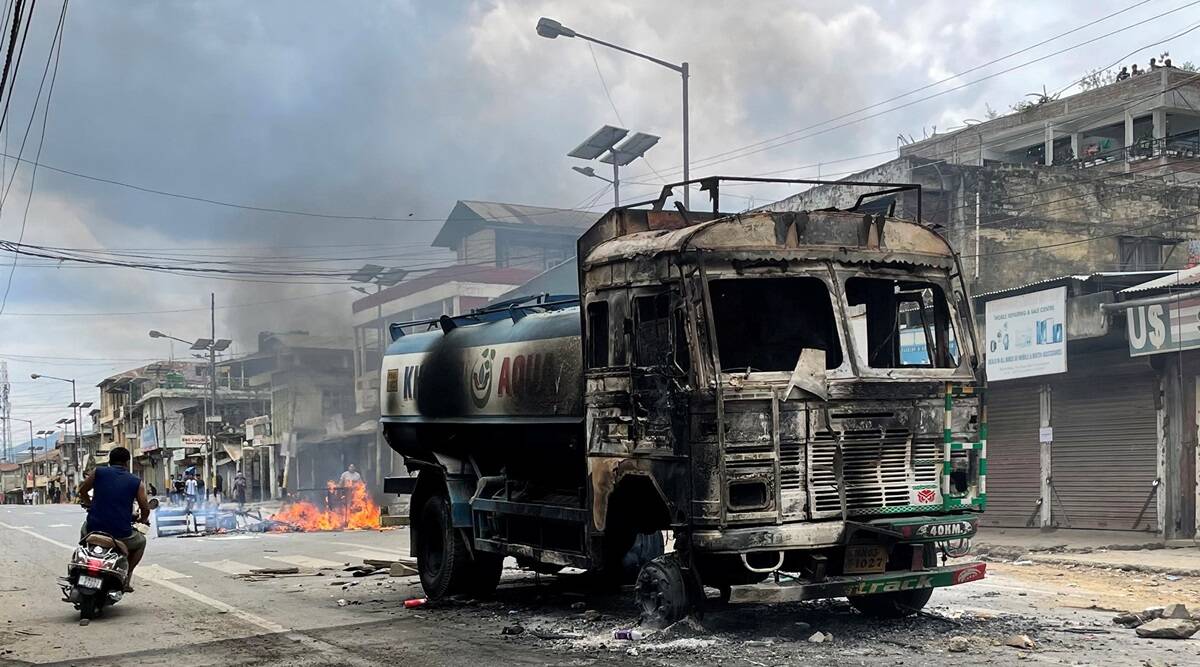The Meitei/Meetei tribal people were recommended for inclusion in the Scheduled Tribes list of the Indian Constitution by the High Court of Manipur on April 19. Tribal organisations in the state, however, were adamantly opposed. While the state’s top tribal organisation, the All Tribal Students Union of Manipur (ATSUM), declared it would protest. The hill tribes think Meiteis have more clout in the state’s politics and economy.

Image Source: Ukhrul Times
In the Torbung region of Churachandpur district, during the Tribal Solidarity March organised by ATSUM, there was violence.
Also Read: What Is Happening In Manipur?
However, why are they demanding the ST status? Here is everything you need to know about it!
1) Manipur’s Ethnic Composition:
Manipur’s issues have a lot to do with geography. The Imphal Valley serves as the playfield in the middle of the state, and the surrounding hills serve as the galleries. The valley has four motorways as its gateways to the outside world, two vital lifelines for the state.
The non-tribal Meitei, who make up more than 64% of the state’s population and produce 40 of the state’s 60 MLAs, are the dominant ethnic group in the valley, which makes up roughly 10% of Manipur’s landmass. Over 35% of identified tribes live in the hills, which comprise 90% of the area’s landmass, although they only send 20 MLAs to the Assembly.

Manipur’s State Assembly
Image Source: The Northeast Affairs
While most Meiteis are Hindus, followed by Muslims, most of the 33 acknowledged tribes—generally categorised as “Any Naga tribes” and “Any Kuki tribes”—are Christians.
2) Who are the Metei Tribe?
The Meitei are Manipur’s largest ethnic group. They are the ones who are typically referred to as Manipuri and are dominating in the capital Imphal. They makeup 64.6% of the state’s population as of the most recent census in 2011, yet only inhabit roughly 10% of Manipur’s total land area.
The other Indian states of Assam, Tripura, Nagaland, Meghalaya, and Mizoram all have large Metei populations. Meitei is also notably present in Bangladesh and Myanmar, which are nearby nations. On the other hand, there are the Nagas and Kukis, two tribal groups that comprise approximately 40% of the population but inhabit 90% of Manipur’s area.

Meitei Traditional Wedding
Image Source: Utsavpedia
The Nagas and Kuki-Zomis are predominately Christian, whilst the Meiteis are predominantly Hindu. According to figures from the 2011 census, Manipur has roughly equal populations of Hindus and Christians, around 41% each.
3) Demand for Scheduled Tribe Status:
The Naga and Kuki-Zomi tribes currently have 34 sub-tribes on the government’s Scheduled Tribes list. However, the Meiteis do not. The Meiteis, on the other hand, have long argued that they should be safeguarded from outsiders and “infiltration” and so desire Scheduled Tribe designation.
The Scheduled Tribe Demand Committee of Manipur, which has advocated for tribal designation since 2012, is led by general secretary K Bhogendrajit Singh, according to The Scroll. He said, “Any citizen of India, including our own hill people, can come and settle in Imphal Valley.”
The Meitei community is upset that tribal people have been buying land in the Imphal Valley, where they currently reside, but are not permitted in the hills.

Manipur High Court
Image Source: LiveLaw
The Meetei (Meitei) Tribe Union stated that they were a recognised tribe before the princely state of Manipur and the Union of India merged in 1949 but lost that identity following the merger in a petition to the Manipur High Court demanding the same. They have contended in court that the necessity to “preserve” the community and “and save the ancestral land, tradition, culture, and language” of the Meiteis goes well beyond reservations in jobs, educational institutions, and tax relief.
The Manipur High Court heard this case on April 19 and ordered the administration to consider the community’s request for inclusion in the reserved category within four weeks and provide a proposal to the Union government for consideration.
4) A Push Against This Demand:
The tribal groups assert that the Meiteis are more developed than them in academic achievement and other areas and have a demographic and political advantage. They believe granting the Meiteis ST designation will result in losing employment prospects and enable them to seize land in the hills, driving the tribal people away.
The Meitei people’s language is listed in the Eighth Schedule of the Constitution, and many of them are eligible for privileges connected with the SC, OBC, or EWS category, according to organisations like the All Tribal Students’ Union of Manipur.
Jawaharlal Nehru University lecturer Thongkholal Haokip wrote in ‘The Politics of Scheduled Tribe Status in Manipur,’ “To the hill tribal people of Manipur, the demand for ST status is a ploy to attenuate the fervent political demands of the Kukis and Nagas, as well as a tacit strategy of the dominant valley dwellers to make inroads into the hill areas of the State.”

Prof Thongkholal Haokip
Image Source JNU



















































































